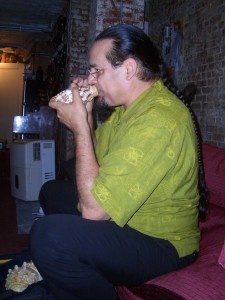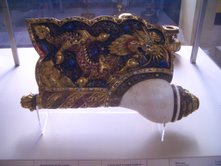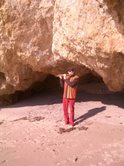By John Kruth
“People were playing shells before there was written language. It goes way back to ancient times. It’s the roots of brass!” Steve Turre exclaimed. “Nobody knows what it sounded like. There’s no written notation or recordings available. The Spanish conquistadors destroyed the culture so we can only guess.”
Turre’s first exposure to the conch shell as a musical instrument came as a teenager  when he sat in with Rahsaan Roland Kirk and the Vibration Society at the Both/And Club in San Francisco. Kirk, a master multi-instrumentalist, was famous for playing three saxophones simultaneously, along with flute, clarinet, and whatever else he could get his hands on. At any given time during a gig, Rahsaan’s music could abruptly spiral into a wild free-for-all, where anything could and did happen.
when he sat in with Rahsaan Roland Kirk and the Vibration Society at the Both/And Club in San Francisco. Kirk, a master multi-instrumentalist, was famous for playing three saxophones simultaneously, along with flute, clarinet, and whatever else he could get his hands on. At any given time during a gig, Rahsaan’s music could abruptly spiral into a wild free-for-all, where anything could and did happen.
“He’d blow the shell and then hit the gong,” Turre recalled with a big grin. “The sound of the shell did something to me. It made me tingle.”
Steve got his first shell in 1970. At first, like Rahsaan, he blew only single notes but soon discovered by putting his hand inside the shell he could lower the pitch and create a wider variety of tones. This sort of playful experimentation came naturally to Turre, a superb trombonist and master of slide and mute techniques.
“I could get octave overtones but it was pretty limited,” Steve confessed. “At the end of a tune, if the shell was in the same key as the chord, I might play the note or play some octave overtones, or a few notes that were in the chord.”
“Then I had this dream that I was playing music on the shells. When I woke up I said, ‘How am I gonna do that?’ You can only get so many notes out of a shell. Then it dawned on me. I gotta get more shells. That’s the only answer!”
In his travels touring the world, Turre collected shells of all shapes and sizes: larger ones for low tones and smaller ones for high notes. Inevitably he began playing two shells at once, a reflection of Rahsaan’s influence.
“At first I was quite shy of presenting the shell,” Steve confessed. “I know how much it hurt Rahsaan when people would accuse him of gimmickry. They misunderstood his genius. He was very sensitive and sincere and I didn’t want to go through that kind of pain.”
In 1978, while on a gig in Mexico City with trumpeter Woody Shaw, Steve (a Mexican-American) played the shells and the crowd went wild. “After the concert,” he recalled, “my relatives told me, ‘Did you know your ancestors used to do that?’ They told me to go check out the museums and pyramids. So on my day off I went to the Archeological Museum.” There, Turre discovered shell instruments similar to the ones he’d been playing. “At the smaller pyramids was a carving of a shell on a temple ruin. There was a fresco of a priest playing the shell, so then and there I knew I was supposed to do this! It was like an awakening. It wasn’t a matter of trying to be different or a way to grab some attention. I realized I didn’t have to be concerned with what people said. I started presenting the shells and much to my surprise I never had anybody accuse me of it being a gimmick. Everybody seems to like it!” he said tweaking his Mongolian mustache.
“You can’t play the shells on just any tune,” he emphasized. “The feeling of the song has to match the spirit of the shells. When you present it right, the meaning comes through,” he ascertained.
“There’s a direct connection between the sound of the shell and the hand drum. It’s a marriage that really clicked for me. The shell is an instrument but it was alive once. It was actually a living organism. It had a spirit. A real hand drum is made from wood and animal skin that was alive once too. There’s something about that!”
The Mayans and Aztecs employed the conch originally as a call or a fanfare to announce the king. In southern Japan, shells are played solo and in groups before announcements and festivities. In meditation practice a long note is held to create peace and tranquillity.
Shells in Tibet are often wrapped in metal which gives them a sharper sound than the natural conch. The smaller trumpet-like mouthpiece creates a nasal, piercing sound that carries a long way. They are primarily used as a call to the sangha of monks together for a meditation session.
When touring India in 1984 with Shaw, Turre purchased shells at the Kali Temple in Calcutta which he played on “Beautiful India” from his Sanctified Shells album.
“The overtones of the shells are very different from brass instruments,” Steve emphasized. “The harmonies are very vibrant and just fill a room. It’s very intense. Recordings don’t totally capture this. You have to be there to experience it.”




